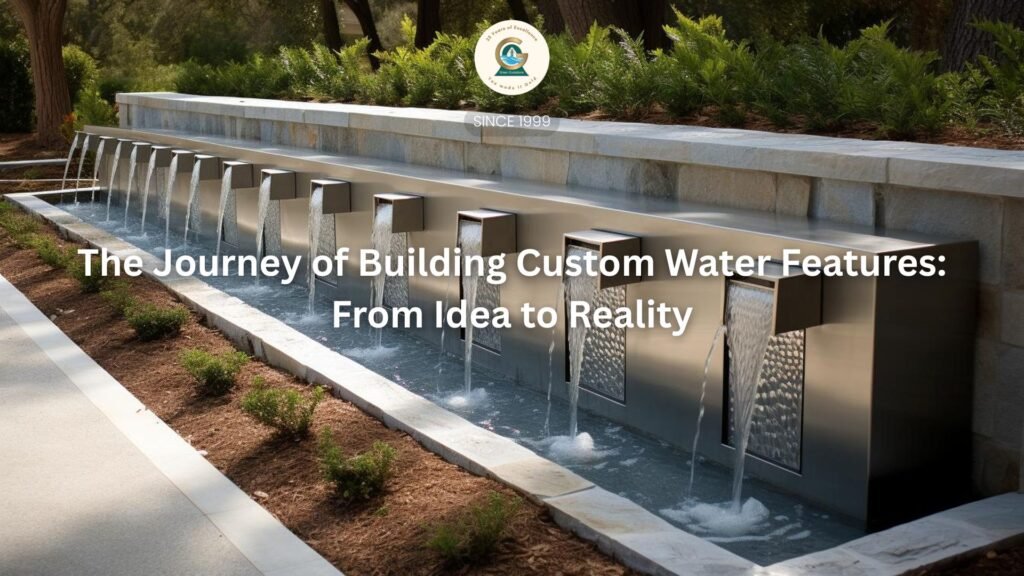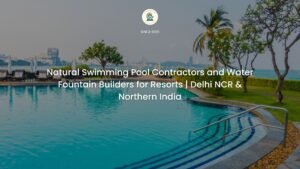When Vision Meets Reality
“I want something that no one else has.”
That’s how most talks get going. Sitting in a sitting room in Vasant Kunj, looking out at a sparse patch of lawn and listening to dreams of calm places and flowing water. The drawing on my notepad appears easy. The trip to make it happen? That’s when the actual narrative starts.
The First Meeting—Reading Between the Lines
Listening is the first step in every project. Not only what clients say, but also what they don’t say.
“I want a fountain” could really imply “I want the sound of water to drown out the sound of traffic.”
“Something grand” might mean “I need to make a good impression on my business partners.”
When someone says “low maintenance,” they mean they don’t know what maintenance is.
A farmhouse owner in Chhattarpur showed me images of Balinese water structures last month. It looks great, but it’s not right for his room at all. We learned through talking that what he really appreciated wasn’t the style but the experience of discovery when you turn a corner and see water where you didn’t expect it.
That understanding changed everything. We didn’t mimic Indonesian architecture; instead, we added hidden water features all around his yard. Every road has something new to show you. He gained his sensation of discovery without having to deal with the trouble of keeping tropical plants alive in Delhi’s weather.
Site Analysis: The Truth Check
During site analysis, pretty drawings confront hard facts. This is where fantasies meet reality, budgets, and the laws of physics.
The Slope Story:
The owner of a property in Gurgaon thought the steep slope was a concern. I saw a chance. That “problematic” slope turned into a beautiful seven-tier waterfall, with each level making a different sound. What looked like a problem turned out to be the project’s best feature.
The Surprise in the Underground:
We hit solid rock halfway through the dig in South Delhi. The client got scared. More blasting would cost too much. Instead, we renovated the area around the rock, making it a natural part of the design. That granite that wasn’t planned is now the main feature of the fountain, with water pouring over its natural curves.
The Problem with Trees:
A full-grown peepal tree was the most important part of the chosen fountain site. If you move it, it will die. It seemed difficult to build around it. What is the answer? We made the tree a component of the water feature by putting streams between its roots and seating spaces in the shade. The tree that almost killed the project became its heart.
Design Development: Where Art and Engineering Come Together
This is when preliminary ideas become into precise blueprints. Each curve, level, and stone placement is looked at closely.
The 3D Revolution
We now employ 3D modeling to show clients exactly what they will get. No more “trust me, it’ll look good.” They can almost stroll around their fountain before we start digging. Changes that would cost lakhs during construction cost nothing while the design is being made.
Drama over Choosing Materials:
After witnessing the Taj Mahal, one client fell in love with white marble. I had to explain why white marble in a Delhi water feature would look like a dirty mess in a few months. We discovered a white granite that looked the same but could take our water better. Sometimes, the best thing you can do is say no.
The Integration Challenge:
Water features don’t stand alone. They should go well with the architecture, improve the landscaping, and blend in with the property’s general design language. A modern minimalist fountain would appear silly next to a traditional haveli, much like fancy Mughal-style water channels would look silly next to modern buildings.
The Dance of Approval
Getting final permission means getting input from a lot of people, each with their own worries:
- The Client: Wants it to be beautiful and one of a kind.
- The Spouse: Is worried about safety and upkeep.
- The Architect: Is worried about the building’s structural integrity.
- The Accountant: Concentrated on budgeting and operational expenses
- The Vastu Consultant: Has certain rules on where to put water
To keep the design’s integrity while balancing various perspectives, you need to be diplomatic, patient, and sometimes willing to make creative compromises.
Construction Chronicles: When Things Get Serious
Day 1–15: Digging
The thrill of breaking ground swiftly gives way to the reality of Delhi’s soil. Sometimes it’s soft clay that won’t stay in form. Sometimes it’s building detritus from who knows when. We once found a whole old foundation that we had to take apart piece by piece.
Days 16–30: Building the Base and the Structure
This is the boring but important part. Proper reinforcing, waterproofing, and rough-in for plumbing. People get worried since it doesn’t look like much. “Where is my fountain?” The solution is in the little things you can’t see but will cherish for years to come.
Day 31-60: The Progress You Can See
The work on the stone begins. Shapes start to show up. Everyone is excited again all of a sudden. This is also when people start asking for “small changes.” “Can we make it a little bit bigger?” Sure, if you want to rip out three weeks’ worth of plumbing work.
Days 61–90: Systems and Finishing
Lights, pumps, filters, and control systems. The technical heart that makes everything work. Then follows the creative finishing, which includes planting pockets, stone textures, and edge elements. These last touches are what make the difference between excellent and great.
The Moment of Truth: The First Flow
The time has come after months of work. Pumps are ready to go. The valves are open. Water is moving.
It can be perfect right away. Changes are needed more often. You need to fine-tune the flow rates, spray patterns, and water levels. It’s like directing an orchestra and making sure that each part plays together.
I remember one job where the customer had fifty people around for the big reveal. The fountain worked perfectly for three minutes, but then a fitting broke loose, making a geyser. It took us ten minutes to fix it, but they were the longest ten minutes of my life.
The Problems That No One Talks About
Politics in the neighborhood:
“Your fountain makes too much noise.” “The construction site is dusty.” “Water spray is getting into my garden.” Managing relationships with neighbors is an unspoken component of every project.
Weather Wars:
When it’s really hot, concrete doesn’t set correctly. Excavations fill up with rain. Every day, you have to clean up after dust storms. We always plan for bad weather, but Delhi still shocks us.
Material Hunt:
That stone that the client liked? Not available right now. What kind of pump? Delivery in three months. Having dependable suppliers and backup plans for backup plans is often the key to success.
After Installation: The Real Test
The first season after installation is the truth. Can it stand the heat of summer? Rain during the monsoon? Cold in the winter? This is when good design shows that it works.
The Learning Curve:
Each feature has its own style. Owners learn when to operate it (it sounds different in the morning than in the afternoon), how the weather affects it, and what upkeep truly means. We keep involved during this time of learning by making changes and teaching.
The Evolution:
Water characteristics that are great change throughout time. Plants grow up. Stone gets a patina. Water finds its own way. What we provide at the end is simply the start. After five years, the best features seem better than they did on day one.
Stories of Success That Keep Us Going
The Meditation Fountain:
A stressed-out CEO sought a place to meditate. We made a round fountain with carefully measured water noises that were loud enough to drown out city noise and soft enough to think about. He later told me that it helped him stay sane during the lockdowns.
The Wedding Venue Change:
A dinner venue that was having trouble built a stunning water wall. There was a huge rise in bookings. Every couple wanted pictures with that water behind them. They made a functional feature the main focus of their marketing.
The Healing Garden:
A rehabilitation clinic asked for a therapeutic water feature. We made sensory experiences by using different textures, noises, and ways of moving. Patients follow their recovery path by interacting with water.
What I’ve Learned in 30 Years
Every project teaches you something new. Every problem we solve teaches us something new. Every happy customer reminds us why we do this business.
Water features aren’t simply for looks. They’re things that happen. They influence how people act, how spaces feel, and what memories are made. When done well, they become a part of life that makes everything else better.
It’s never easy to go from idea to making something. It moves like water, going past everything in its way, sometimes pooling in places you wouldn’t anticipate, and always advancing toward completion. Like water, each endeavor changes us as much as we change it.
GreenEvolutions has been turning ideas into water features since 1991. Each project journey is different, with its own problems and benefits. This post talks about what we’ve learned from making unique water features all throughout Delhi NCR.




